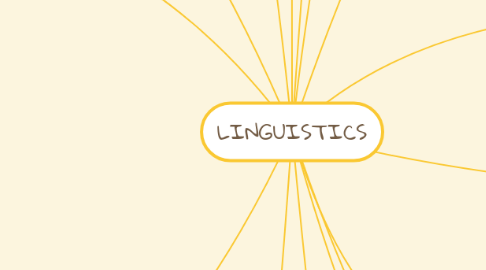
1. Phonology
2. The study of sound patterns languages
2.1. Phoneme
2.1.1. Smallest segment of sounds which can distinguish two words.
2.2. Allophone
2.2.1. A variant of phoneme in paerticular language
3. Pragmatic
3.1. Definition
3.1.1. The study of speaker meaning.
3.2. Context
3.2.1. Physical
3.2.2. Linguistic
3.2.3. Social
3.2.4. Epistemic
3.3. Speech Act
3.3.1. Indirect Speech Act
3.3.2. Direct Speech Act
3.4. Speech Act
3.4.1. Representative
3.4.2. Directive
3.4.3. Commisive
3.4.4. Expressive
3.4.5. Declaration
3.5. Grice's Maxim
3.5.1. Maxims of Quality
3.5.2. Maxims of Relevance
3.5.3. Maxims of Quantity
3.5.4. Maxims of Manner
3.6. Politeness
3.6.1. Face Threatening Act - On record - Off record
3.6.2. Face Saving Act - Positive politeness - Negative politeness
4. Morphology
4.1. Free morphemes
4.1.1. Lexical Morpheme
4.1.2. Functional Morpheme
4.2. Bound Morpheme
4.2.1. Derrivational Morpheme
4.2.2. Inflectional Morpheme
4.3. Word Formation Processes
4.3.1. Coinage
4.3.2. Blending
4.3.3. Compounding
4.3.4. Conversion
5. Phonetic & Phonology
5.1. Phonetic
5.1.1. The study of aounds and their priduction
5.1.1.1. Consonant
5.1.1.1.1. Place
5.1.1.1.2. Manner
5.1.1.2. Vowels
5.1.1.2.1. High
5.1.1.2.2. Mid
5.1.1.2.3. Low
5.1.1.2.4. Front
5.1.1.2.5. Lentral
5.1.1.2.6. Back
5.1.1.2.7. Dipththongs
5.1.1.2.8. Nazalitation
6. psycholinguistics
6.1. language comprehension
6.1.1. understanding what other people say and write
6.2. language production
6.2.1. the production of spoken or written language
6.3. language acquistion
6.3.1. how people learn to speak and the mental processes involved
6.3.1.1. second language acquistion
6.3.1.2. the stages
6.3.1.2.1. cooing-6 months
6.3.1.2.2. babbling-9 months
6.3.1.2.3. one word utterances-12 months
6.3.1.2.4. telegraphist speech-2 years
6.3.1.2.5. normal speech-5 years
6.4. speech problems
6.4.1. slips of tongue
6.4.2. stuttering
6.4.3. aphasia
7. Tentative phrases
8. Accents
9. Hypernymy
10. phonologicalistics
10.1. rhyme
10.1.1. assonance
10.2. allication
10.3. correlation of the sound form and meaning
11. Complementary
12. Sociolinguistics
12.1. Dialect
12.1.1. Vocabulary
12.1.2. Sound
12.1.3. Syntax
12.2. Registers
12.2.1. Topic discussed
12.2.2. Formality of occasion
12.2.3. Medium used
12.2.3.1. Spoken
12.2.3.2. Written
12.2.3.3. Signed
12.3. High-density network
12.4. Social Networks
12.4.1. Low-density network
12.5. Language & Sex
12.5.1. Women
12.5.1.1. Question intonation
12.5.1.2. Commands=joint actions
12.5.2. Men
12.5.2.1. Straightforward
12.5.2.2. Insecure style
12.5.2.3. Direct orders
13. Semantics
13.1. Synonymy
13.2. Antonymy
13.2.1. Gradable
13.2.2. Relational
13.3. Ambiguity
13.3.1. Polysemy
13.3.2. Homonyms
13.3.3. Homophones
13.4. Hyponymy
13.5. Homographs
13.6. Metaphors
13.7. Componential Analysis
13.8. Prototypes
14. Syntax
14.1. Lexical/Content
14.2. Generative Grammar
14.3. Tree Diagram
14.4. Types of Sentences
14.4.1. Simple Sentences
14.4.2. Compound
14.4.3. Complex
14.4.4. Compound-Complex
15. stylistics
15.1. lexical
15.1.1. connotations
15.1.1.1. expressive
15.1.1.2. evaluative
15.1.1.3. emotive
15.1.1.4. neologisms
15.1.1.5. their behavior
15.1.1.6. dialectal words
15.1.2. correlation of the message
15.2. functional
15.3. stylistics of encoding
15.3.1. figurative language
15.3.2. sound techniques
15.3.3. communicative situation
15.3.4. structural devices
15.3.5. irony
15.3.6. register
15.4. morphological
15.5. grammatical
15.5.1. syntactical
15.6. individual style study
15.6.1. studies the style of the author
